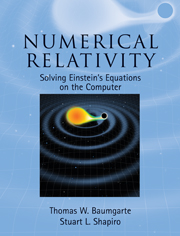Book contents
- Frontmatter
- Contents
- Preface
- Suggestions for using this book
- 1 General relativity preliminaries
- 2 The 3 + 1 decompostion of Einstein's equations
- 3 Constructing initial data
- 4 Choosing coordinates: the lapse and shift
- 5 Matter sources
- 6 Numerical methods
- 7 Locating black hole horizons
- 8 Spherically symmetric spacetimes
- 9 Gravitational waves
- 10 Collapse of collisionless clusters in axisymmetry
- 11 Recasting the evolution equations
- 12 Binary black hole initial data
- 13 Binary black hole evolution
- 14 Rotating stars
- 15 Binary neutron star initial data
- 16 Binary neutron star evolution
- 17 Binary black hole–neutron stars: initial data and evolution
- 18 Epilogue
- A Lie derivatives, Killing vectors, and tensor densities
- B Solving the vector Laplacian
- C The surface element on the apparent horizon
- D Scalar, vector and tensor spherical harmonics
- E Post-Newtonian results
- F Collisionless matter evolution in axisymmetry: basic equations
- G Rotating equilibria: gravitational field equations
- H Moving puncture representions of Schwarzschild: analytical results
- I Binary black hole puncture simulations as test problems
- References
- Index
F - Collisionless matter evolution in axisymmetry: basic equations
Published online by Cambridge University Press: 05 March 2013
- Frontmatter
- Contents
- Preface
- Suggestions for using this book
- 1 General relativity preliminaries
- 2 The 3 + 1 decompostion of Einstein's equations
- 3 Constructing initial data
- 4 Choosing coordinates: the lapse and shift
- 5 Matter sources
- 6 Numerical methods
- 7 Locating black hole horizons
- 8 Spherically symmetric spacetimes
- 9 Gravitational waves
- 10 Collapse of collisionless clusters in axisymmetry
- 11 Recasting the evolution equations
- 12 Binary black hole initial data
- 13 Binary black hole evolution
- 14 Rotating stars
- 15 Binary neutron star initial data
- 16 Binary neutron star evolution
- 17 Binary black hole–neutron stars: initial data and evolution
- 18 Epilogue
- A Lie derivatives, Killing vectors, and tensor densities
- B Solving the vector Laplacian
- C The surface element on the apparent horizon
- D Scalar, vector and tensor spherical harmonics
- E Post-Newtonian results
- F Collisionless matter evolution in axisymmetry: basic equations
- G Rotating equilibria: gravitational field equations
- H Moving puncture representions of Schwarzschild: analytical results
- I Binary black hole puncture simulations as test problems
- References
- Index
Summary
Here we list the key equations describing a mean-field, particle simulation scheme that can treat the evolution of collisionless matter in axisymmetry according to general relativity. The scheme is a generalization of the one described in Chapter 8.2 for spherical systems and employs the standard ADM form of the field equations as listed in Box 2.1. We adopt spherical polar spacetime coordinates (t, r, θ,ϕ), assume axisymmetry and specialize to the case where there is no net angular momentum. In axisymmetry all quantities are functions only of (t, r, θ). We also impose maximal slicing and quasi-isotropic spatial coordinates as our gauge conditions. This spatial gauge condition reduces to isotropic coordinates for Schwarzschild geometry. The field equations listed below constitute a fully constrained approach to solving the Einstein field equations for this problem, i.e., one which solves all of the constraint equations in lieu of integrating evolution equations for some of the variables. Fully constraint schemes have the advantage over unconstrained schemes that the constraints are guaranteed to be satisfied at all times, which may in some cases also eliminate some instabilities associated with the evolution equations. Their disadvantage is that the constraints constitute elliptic equations, which typically require more computational resources to solve than explicit time evolution equations. This disadvantage is not so severe, however, in 1 + 1 or 2 + 1 spacetimes. A similar set of variables and field equations to the ones summarized below has been used to simulate the gravitational collapse of hydrodynamic fluids and vacuum gravitational waves6 in nonrotating, axisymmetric spacetimes, as well as the head-on collision of neutron stars.
- Type
- Chapter
- Information
- Numerical RelativitySolving Einstein's Equations on the Computer, pp. 629 - 633Publisher: Cambridge University PressPrint publication year: 2010



